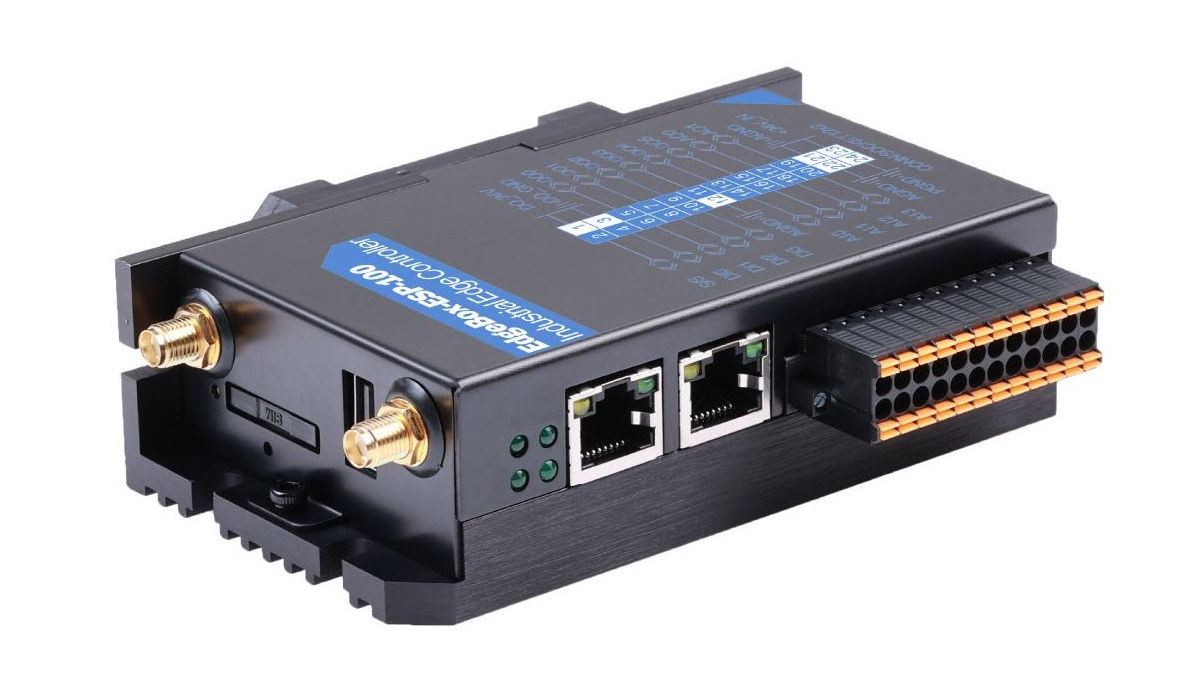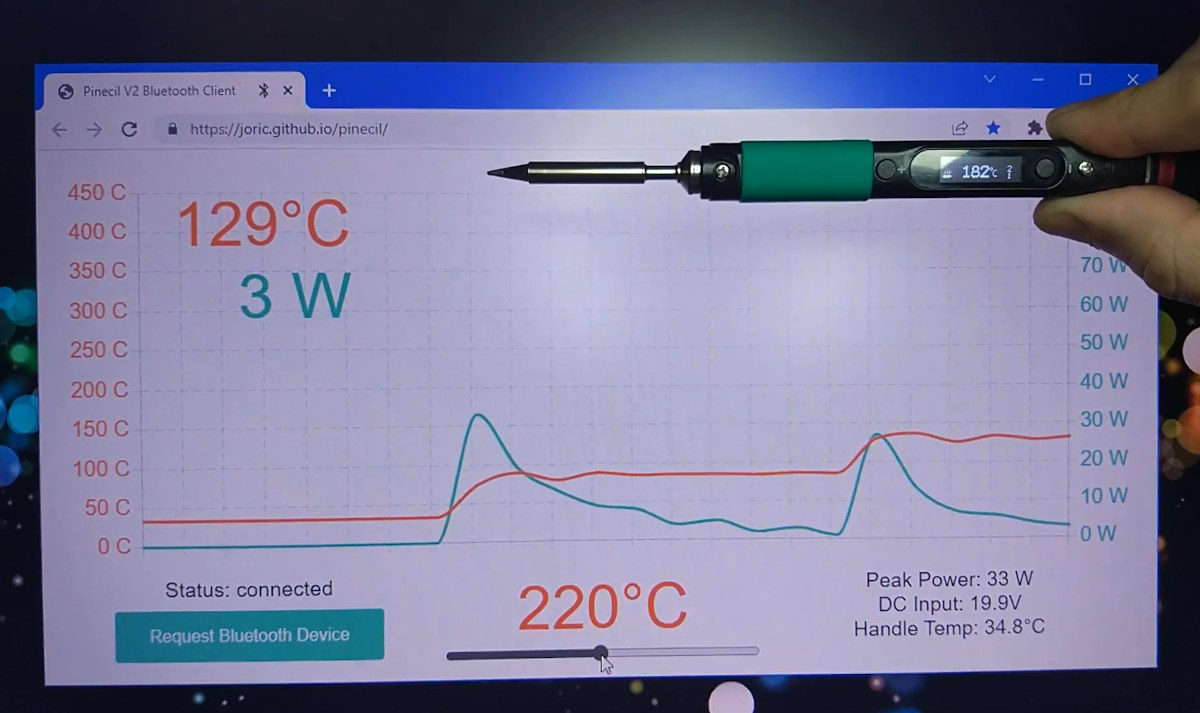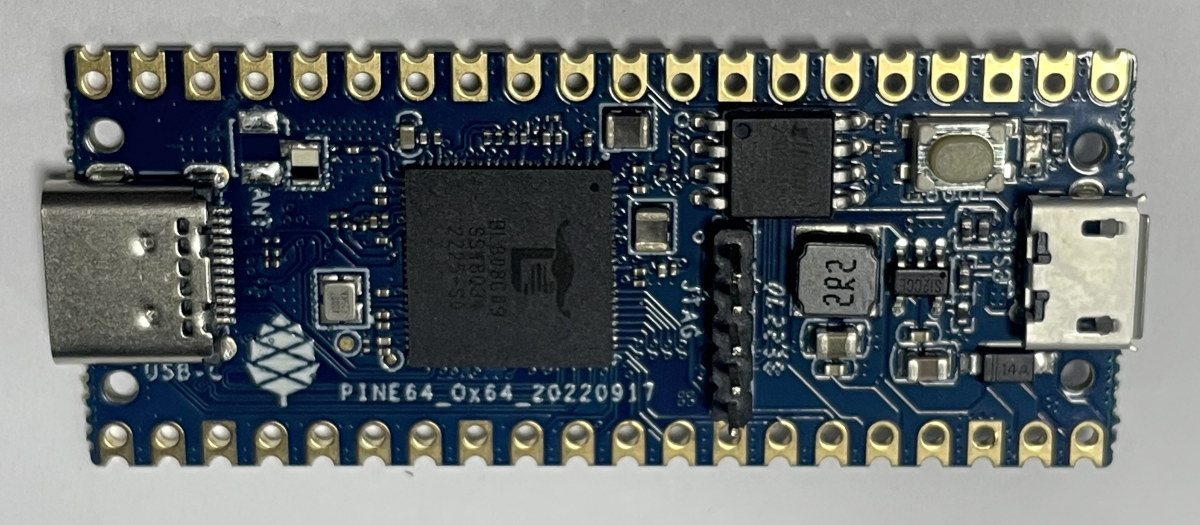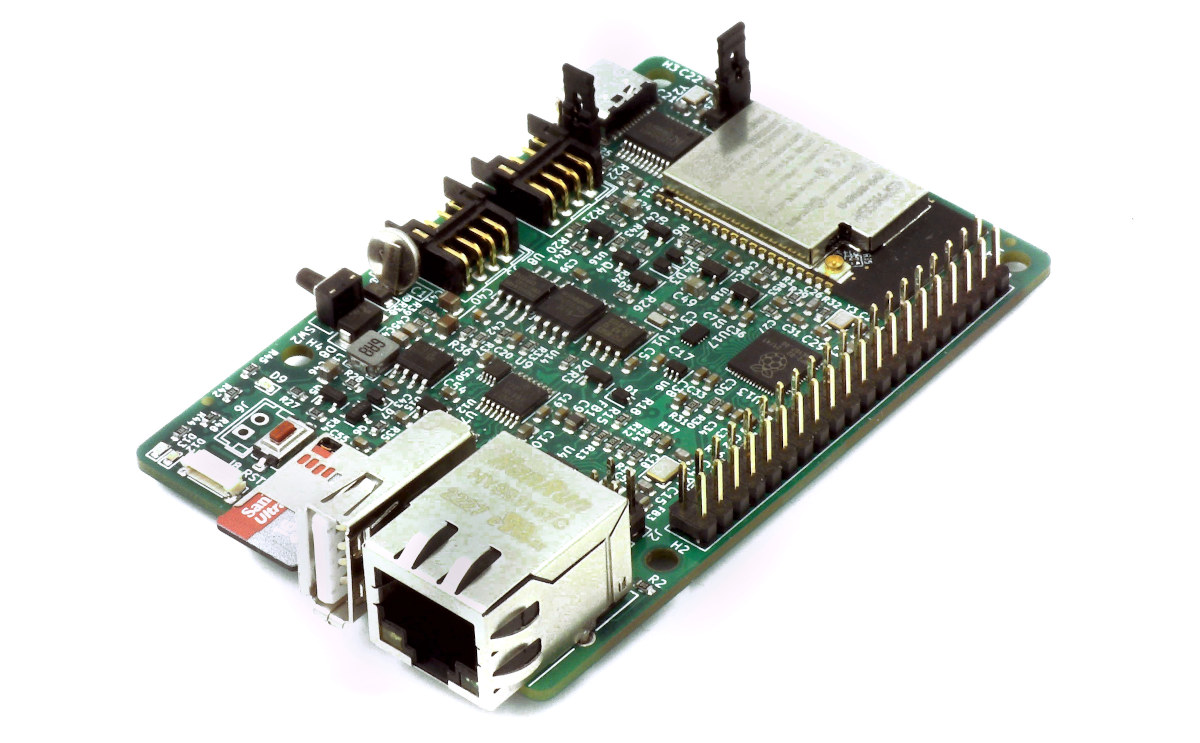We’ve previously covered the EdgeBox-RPi4 industrial controller powered by a Raspberry Pi Compute Module 4 and plenty of I/Os such as RS485, RS232, digital inputs and outputs, and connectivity options such as Gigabit Ethernet, WiFi 5, Bluetooth 5, and 4G LTE. But if you don’t quite need the power of a Linux controller, the EdgeBox-ESP-100 industrial edge controller based on an ESP32-S3 dual-core WiFi and Bluetooth microcontroller and offering a similar set of features, albeit with twists, may be an interesting option. EdgeBox-ESP-100 specifications: Microcontroller – Espressif Systems ESP32-S3 dual-core Tensilica LX7 microcontroller @ 240 MHz with AI vector instructions, 512KB RAM Memory – 8MB PSRAM Storage – 16MB Flash Network connectivity 10/100M Ethernet RJ45 port 2.4 GHz WiFi 4 and Bluetooth 5.0 LE via ESP32-S3 4G LTE cellular via SIMCom A7670G LTE Cat 1 module Optional support for LoRa (replaces the A7670G module) Serial & I/Os via terminal blocks […]
Pinecil V2 Bluetooth LE soldering iron gets a web interface
It’s now possible to make use of the Pinecil V2 soldering iron‘s Bluetooth LE connectivity through a web-based interface used to monitor and/or set the temperature and power of the RISC-V soldering iron. When the Pinecil V2 soldering iron was launched with a Bouffalo Lab BL706 RISC-V Bluetooth microcontroller last summer, we were told there were main potential cases to make use of the Bluetooth LE features: OTA firmware upgrade and remote telemetry and control. The latter is now being taken care of by Joric who has written a web application to visualize telemetry data and even control the temperature of the soldering iron. To be able to use the Bluetooth features, you’ll first need to install the latest Pinecil V2 firmware with blisp flashing utility before going to https://joric.github.io/pinecil to pair your soldering iron as explained in the wiki. Note the implementation relies on the Web Bluetooth API which […]
$6 Pine64 Ox64 SBC features BL808 64-bit/32-bit RISC-V multi-protocol WiSoC with 64MB RAM
Pine64 Ox64 is a single board computer powered by Bouffalo Lab BL808 dual-core 64-bit/32-bit RISC-V processor with up to 64MB embedded RAM, multiple radios for WiFi 4, Bluetooth 5.0, and 802.15.4 (Zigbee), as well as an AI accelerator. The board also features up to 16MB XSPI NOR flash, a MicroSD card socket, a USB 2.0 OTG port with support for a 2-lane MIPI CSI camera module, and two 20-pin GPIO headers for expansion. It measures just 51 x 21mm, or in other words, is about the size of a Raspberry Pi Pico W. Pine64 Ox64 specifications: SoC – Bouffalo Lab BL808 with: CPU Alibaba T-head C906 64-bit RISC-V core @ 480MHz Alibaba T-head E907 32-bit RISC-V core @ 320MHz Alibaba T-head E902 32-bit RISC-V @ 150MHz Memory – 728KB SRAM, 64MB embedded DRAM AI accelerator – NPU BLAI-100 (Bouffalo Lab AI engine) for video/audio detection/recognition Wireless 2.4 GHz 802.11 b/g/n […]
Inkplate 2 is a 2.13-inch WiFi ePaper display programmable with Arduino or MicroPython (Crowdfunding)
Inkplate 2 wireless ePaper display is by far the smallest display from Soldered Electronics with a 2.13-inch 3-color ePaper display while previous Inkplate models rely on 6-inch to 9.7-inch ePaper displays. The tiny display board integrates an ESP32 dual-core wireless microcontroller that drives the display, provides WiFi and Bluetooth connectivity plus some I/Os, and can be programmed with the Arduino IDE or MicroPython. Inkplate 2 specifications: Wireless module – ESP32-WROVER-E module with ESP32 dual-core microcontroller with Wi-Fi 4 & Bluetooth 4.0 connectivity, 8MB PSRAM, 4MB flash (Note: The product’s description lists 8MB flash, and 4MB RAM, but there’s no ESP32-WROVER-E in this configuration) Antenna- External IPX antenna Display – 2.13-inch ePaper display with 212×104 resolution (111 DPI) Red, black, and white colors 15 seconds full refresh time (no partial update) USB – 1x USB Type-C port for power and programming via CH340 USB to TLL chip Expansion 20-pin header with […]
LOLIN S3 Pro ESP32-S3 board offers display port, MicroSD card slot
LOLIN S3 Pro is a WiFi & Bluetooth LE IoT board built around the ESP32-S3-WROOM-1 modules with various I/Os including a display port, a microSD card slot, and a LOLIN I2C connector. The wireless module ships with 16MB QSPI flash and 8MB PSRAM, and the board also features two 16-pin headers with ADC, DAC, I2C, SPI, UART, etc…, a USB Type-C port, and support for a LiPo batteries with 500mA charging. LOLIN S3 Pro specifications: Wireless module – ESP32-S3-WROOM-1 module with: Espressif Systems ESP32-S3 dual-core Tensilica LX7 @ up to 240 MHz with vector instructions for AI acceleration, 512KB RAM, 2.4 GHz WiFi 4 and Bluetooth 5.0 LE with support for long-range, up to 2Mbps data rate, mesh networking 16MB QSPI flash 8MB PSRAM PCB antenna Storage – MicroSD card socket Display I/F – Display port for “TFT and EPD” displays USB – 1x USB Type-C port Expansion 2x […]
EsPiFF board combines ESP32 module with RP2040 MCU in the Raspberry Pi 4 form factor (Crowdfunding)
The EsPiFF board may look like a Raspberry Pi 4 Linux SBC but it is equipped with an ESP32-WROVER WiFi and Bluetooth module together with a Raspberry Pi RP2040 microcontroller that acts as a co-processor. The goal here is to provide a Raspberry Pi 4 replacement for applications that require higher reliability and even 24/7 operation without necessarily needing the processing power and multimedia capabilities of the Broadcom BCM2711 Arm processor found in the Pi or the versatility of a Linux operating system. EsPiFF board specifications: Wireless module – ESP32-WROVER module with dual-core ESP32-D0WDQ6 microcontroller with 2.4 GHz WiFi 4 and Bluetooth, 8 MB PSRAM and 16 MB flash Co-processor – Raspberry Pi RP2040 dual-core Cortex-M0+ microcontroller @ up to 133 MHz with 16MB flash used to emulate the Raspberry Pi’s GPIOs on the 40-pin header Additional storage 2 KB of fast FRAM for permanent storage of process data. (faster […]
Bluetooth LE to support 6 GHz frequency band
So far, the popular Bluetooth wireless communication protocol would only rely on the 2.4 GHz frequency band, but this may change in the future, as the Bluetooth Special Interest Group (SIG) has recently announced a new “specification development project” to add the 6 GHz frequency band to Bluetooth LE. Mark Powell, CEO of the Bluetooth SIG “explains” the move: The Bluetooth SIG community is constantly evolving the technology to meet ever expanding market demands for wireless communications. Expanding into the 6 GHz spectrum band will ensure the community can continue to make the enhancements necessary to pave the way for the next twenty years of Bluetooth innovation. I get it that’s a long-term move, but it does not explain exactly why the additional 6 GHz (and 5 GHz) bands may be necessary. I’d just suspect as more devices such as BLE sensors get more widely added that adds to the […]
Giveaway Week – GL.iNet GL-S10 BLE to MQTT Gateway
The sixth prize of this year’s Giveaway Week will be GL.iNET GL-S10 BLE to MQTT gateway based on the ESP32 microcontroller and offering Ethernet, WiFi, and Bluetooth LE connectivity. The gateway is used to gather data from Bluetooth LE devices such as beacons and can be used in warehouses, shopping malls, airports, exhibition halls, tourist attractions, etc… for personnel management, asset management, environmental monitoring, indoor navigation, and more. I reviewed the ESP32-based BLE to MQTT gateway with the provided BLE beacon at the end of last year using MQTT X open-source client and the GL-S10 Tool App for Android. It allowed me to send commands through MQTT topics, for example, to set or retrieve the beacon’s (WiFi) configuration, and receive the data through MQTT subscriptions. Some of the data include the MAC address, RSSI, ad (Broadcast data advData), and a timestamp. It took some effort to get it working, but […]










